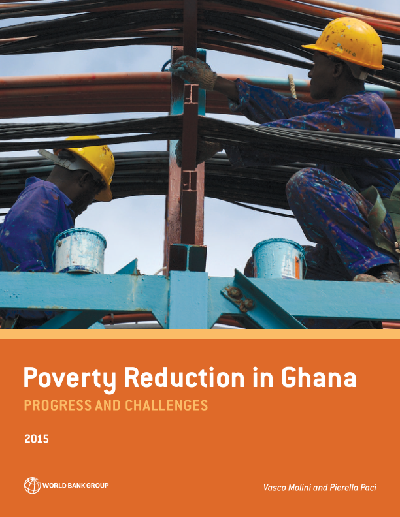



收藏
纠错
加纳在过去的二十年中一直保持稳定而强劲的增长,主要是通过改变其经济结构来实现的:随着经济逐渐从农业转向服务业,该国的生产力有了显着提高。自2005年以来,农业增加值在GDP中所占的份额下降速度更快,而服务业所占份额几乎保持不变。就业已根据经济结构的变化进行了调整,从乡村逐步转移到城市地区。教育态度有所改善,更多的人涌入城市并增加了家庭收入,生活在贫困中的家庭数量明显减少。展望未来,加纳要充分发挥其潜力,就必须继续执行2014年实施的稳定计划,对财政纪律的持续承诺。其他优先事项是继续发展工人的技能,支持进一步的结构转型,并为仍然生活在贫困中的大部分人口扩大安全网和收入机会。
加纳减贫:进展与挑战 Executive Summary Ghana has posted a strong growth performance during the past two decades. After more than a decade of stable annual growth in gross domestic product (GDP) at between 4 and 5 percent, growth began to pick up in the early 2000s and reached a steady rate of nearly 8 percent after 2006 (figure 1). Over the last 20 years, the Ghanaian economy has almost always grown more quickly than have the economies of other Sub- Saharan African countries (Africa hereafter) and at rates similar to those of lower-middle-income countries. Rapid growth translated into accelerated poverty reduction. The poverty rate fell by more than half between1991and 2012, from 52.7 percent to 21.4 percent (figure 2). The coun- try seems easily on track to reduce the poverty rate in line with Millennium Development Goal 1. Its performance compares well with that of other countries in Africa. In 2012, the poverty rate in Ghana was less than half the African aver- age of 43 percent, while in 1991, it had been only 10 percent lower than the African rate.l The . extreme poverty rate declined even more quickly, dropping from 37.6 percent in 1991 to 9.6 percent in 2012. 【更多详情,请下载:加纳减贫:进展与挑战】
